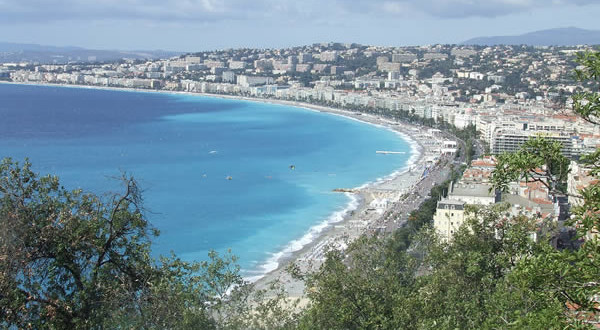¿Adónde quieres viajar?- Spanish NoviceMid

The beach.
¿Adónde quieres viajar? Spanish Novice-Mid
Proficiency Level:
Novice Mid
Description:
In this activity, students will take a fun quiz to find out what kind of traveller they are. Students will also respond to a multitude of questions regarding their likes/dislikes in a group conversation setting. Students will learn more about traveling and how to answer questions regarding likes/dislikes. Students will also learn to answer questions about places.
Keywords:
Travel, Lodging, Food, Mountains, Beach, Hotel, Survey, Outdoors, Interview, World
World-Readiness Standards:
- “Standard 1.1 Students engage in conversations, provide and obtain information, express feelings and emotions, and exchange opinions.”
- “Standard 1.2 Students understand and interpret spoken and written Spanish on a variety of topics.”
- “Standard 1.3 Students present information, concepts, and ideas in Spanish to an audience of listeners or readers on a variety of topics.”
Relevant Idaho State World Language Standards:
- COMM 1.1 - Interact and negotiate meaning (spoken, signed, written conversation) to share information, reactions, feelings, and opinions
- COMM 2.1 - Understand, interpret, and analyze what is heard, read, or viewed on a variety of topics.
- COMM 3.1 - Present information, concepts, and ideas to inform, explain, persuade, and narrate on a variety of topics using appropriate media in the target language.
Relevant NCSSFL-ACTFL Can-Do Statements:
- I can answer questions about what I like and dislike to do on vacation
- I can describe and talk about places I want to visit and what I want to do there
- I can ask other people about what they like and dislike to do on vacation
Materials Needed:
- Buzzfeed quiz (Loaded onto one device for each student)
- Vis-A-Vis Markers (One per student)
- Google Slideshow
- Heads Up Cards
Warm-up
1. Begin by introducing the Can-Dos for today’s activity, located on the Google Slideshow.
“Vamos a leer los Can-Do Statements."
2. Students will begin by playing a game of Head's Up. Start with the Head's Up cards in a deck, facing towards the middle of the table. The students are going to play as a group.
“Hoy vamos a jugar el juego de Heads Up."
3. One student is going to choose a card from the deck without looking. The student is going to put a card on their forehead so that the rest of the group can see. The rest of the group is going to give hints to the person who has the card on their forehead. The students will give the hints in Spanish only.
"Ustedes van a jugar en un grupo grande. Un estudiante va a escoger una tarjeta de la baraja sin verla. El estudiante va a poner la tarjeta en su frente (Point to forehead) para que el resto del grupo pueda ver. El resto del grupo va a dar pistas a la persona que tiene la tarjeta en la frente. Ustedes van a dar pistas en español solamente."
Main Activity
Parte A-
1. Hand out a device with the Buzzfeed Quiz to each student, put them in partners. Students will take turns asking one their partner the questions on the quiz, and circling their answer using the Vis-A-Vis markers.
“¡Ustedes van a hacer una entrevista con un amigo para averiguar qué tipo de viajero tu amigo es! En parejas, deben hacer las preguntas el uno al otro. Llena (Gesture to circling an answer on the quiz) la hoja con la respuesta de tu pareja. Tomen turnos preguntando y leyendo las respuestas en voz alta."
2. After the students have interviewed their partners to find out their answers to the quiz, tell the following to your students:
"Ahora, cuenten el número de las As, Bs, Cs, y Ds en la prueba de tu compañero. Dime la letra con más respuestas. ¡Voy a darte una tarjeta que corresponde con la letra!"
3. Click to the slide on the Google Slideshow that shows the quiz results. Have students read the description of the personality they got from their quiz answers.
"Vamos a ver la clave de las personalidades según los resultados de la prueba."
4. Have students share which type of traveler they are with the group. Ask them if they agree with the results.
"¿Cuáles personalidades tienen según sus resultados? ¿Son ciertos o falsos?"
Parte B-
1. Use the following questions to have discussion with the students. (These questions are displayed on slides in the Google Slideshow as well)."Use las preguntas para tener una conversación."
¿Cuál es tu pasatiempo favorito?
¿Cuál es tu café favorito en el centro de Boise?
¿Hay un café en otro lugar que te guste ir?
¿Prefieres ir al museo o nadar en el mar cuando estás de vacaciones?
¿A tí te gusta jugar los videojuegos? ¿Cuál es tu videojuego favorito?
Cuándo estás de vacaciones, ¿Qué actividades te gustan hacer?
¿A qué hora prefieres almorzar durante una vacación?
¿Dónde quieres que sean tus vacaciones este verano?
¿Prefieres viajar con tus amigos o con tu familia? ¿Por qué?
Wrap-up
Ask students some of the following questions to finish the activity:
1. Nombra una cosa que te gusta traer contigo para la vacaciones.
2. Nombra un lugar que te gusta ir por diversión
3. Nombra el destino perfecto para una vacación.
4. Nombra el destino más horrible para una vacación.
End of lab:
• Read Can-Do statements once more and have students evaluate their confidence.
(Use thumbs up/thumbs down or download our student cards.)
• Encourage students to be honest in their self-evaluation.
• Pay attention, and try to use feedback for future labs!
Relevant NCSSFL-ACTFL Can-Do Statements:
- I can answer questions about what I like and dislike to do on vacation
- I can describe and talk about places I want to visit and what I want to do there
- I can ask other people about what they like and dislike to do on vacation